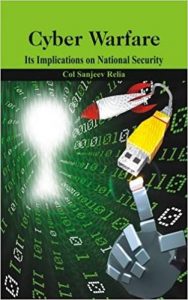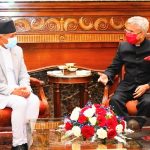
Nowadays globally, changes in military doctrines favouring the need to raise cyber commands reflect a shift in strategies and traditional security paradigm, which include building deterrence in cyberspace. Recent developments in India’s defence and security strategy suggests the armed forces too are working on “offensive” cyber capabilities. The following book review explores the content and insights of Col Sanjeev Relia titled Cyber Warfare: Its Implications on National Security. The foreword deals with the contextualization of the circumstances which motivated the author to bridge the critical gap in conceptual thinking that has, until now, lagged behind due to narrow interpretation of National Security and Cyber Space. The concept of National Security has gone mammoth changes as it is now not only limited to the security of our land borders, skies and territorial waters. National security today encompasses military security, political security, economic security, environmental security, security of energy and natural resources and cybersecurity.
The introductory chapter defines what cyberspace is and how cyberattacks are carried out. The book traces back the evolution of different means of warfare through human history. Information and Communication Technologies (ICT) too had impacted and transformed warfare to a great extent. The author describes how, after years of technological advancements, Cyberspace emerged as a domain of warfare. He examines and interprets the complex definition of Cyberspace coined out by different subject matter experts for a better understanding among the readers. Furthermore, having understood the characteristics of cyberspace, he analyses the threats that one faces in cyberspace. He goes on to explain the fundamental vulnerabilities of Cyberspace and later on proceeds further to classify and explain the modus operandi of cyberattacks. At the end of the first chapter, he declassifies the definition of cyber warfare at the operational and strategic levels, which arouses the reader’s interest to understand the nexus between Cyberspace and cyber warfare.
The second chapter of the book addresses the global and regional cyber scenario, where the author analyses the indicators of the cyber power of a nation, locating the cyber power hotspots on the globe and investigate some of the recent cyber conflicts. The indicators of the cyber power of a nation can be divided into two broad categories: The Government Sector and the Private Sector. Both the sectors are equally important as an indicator of the cyber warfare potential of a nation. Proceeding further, the author studies and explains the reason why nations like the United States of America, China, Iran, Israel, Pakistan, and Korea are cyber power hotspots around the globe. The author then investigates some of the recent and most prominent cyberattacks around the globe, including the first cyberwar during the Russo-Georgian War in 2008.
Chapters three and four discuss the threat to national critical info-infrastructure (CII) and how the CII is being protected in India presently. The Telecom sector, Satellite Networks, Nuclear Power Plants, Smart Grid form an integral part of the critical info-infrastructure. The author highlights that any damage or disruption of CII will have an overwhelming impact on National Security, as the whole economy and essential services are dependent upon it. As more and more industrial control systems get automated and networked, the protection of CII assumes a new dimension. The author lays out a roadmap to secure critical info-infrastructure in India. Presently, the Private sectors own 50 to 60 per cent of the nation’s CII. Therefore, the author suggests that a multi-stakeholder approach and legislation should be adopted by the Government of India that defines their role in governing and safeguarding the CIIs. At the end of chapter four, the author underlines the need to create a framework in the country to address and manage cybersecurity risks in particular and improve the cybersecurity posture of the Nation’s critical info infrastructure as a whole.
The fifth chapter describes a cyberwar model at a strategic level as well as operational level. The author starts by describing the incident which occurred in August 2012, where thousands of citizens from the North-eastern part of the nation received text messages warning them that they would be attacked because of the violence that flared between the mostly Hindu Bodo tribe and Bangladeshi Muslim immigrants. This incident brought out the fact that the cyber domain can be used to cause widespread terror and panic among the citizens. Before explaining how cyberwar can be undertaken at the strategic level and operational levels, the author explains the objectives behind waging a war and re-examines the definitions of cyber warfare for a clear understanding of the operational use. Cyber-attacks by a single entity against a country and its community, primarily but not exclusively to influence the behaviour of the target country, counts as Strategic cyber warfare. This type of warfare can be undertaken at any time, without the two nations or state actors being in a state of war. On the other hand, Operational cyberwarfare consists of wartime cyberattacks against military targets and military-related civilian targets. This implies that the critical information infrastructure of the country and military networks today are both equally vulnerable to the enemy’s cyberattacks. The author also examines the four pillars of cyberwar, namely intelligence, technology, logistics and command in waging successful cyber warfare. At the end of the chapter, the author turns our attention to Cyber deterrence, which is relatively unexplored. The goal of cyber deterrence is to prevent the enemy from launching attacks in the future by threatening to attack or attacking their technology, or by more palpable means. But due to certain ambiguities, the author questions the use of cyber threats as a tool of deterrence.
The last chapter provides specific recommendations to prepare India to face the cyber threat looming over the country. The continuous rapid development of information and communication technologies, globalization, the exponential increase in data volumes in all types of organizations, and the growing number of diverse types of devices connected to data networks have an impact on daily life, the economy, and the general growth of our nation. This high dependence of our critical infrastructure on ICT exposes it to the vulnerabilities of cyberspace. The author highlights efforts at the international level, where various forums have taken a binding decision on cyberwar treaties and cyberwar arms convention. On the national level, the author suggests that India should carve out an action plan to identify and target the vulnerabilities existing in cyberspace. The author recommends the creation of cyber warfare-enabled Armed Forces and cyber formations; integration and development of concepts for the application of cyber power for effective cyber deterrence; and immediate release of an ‘Integrated National Cyber Doctrine’ to facilitate the protection of Indian cyberspace.
In short, this book by Col Sanjeev Relia is an attempt to understand the various nuances of cyber warfare and how it affects our national security. Based on the cyber threat environment, the book recommends a framework for cyber doctrine and cyber strategies as well as the organizational structure of the various organizations in which the country needs to invest.













